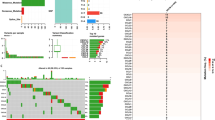Abstract
Purpose
Chemokines influence both tumor progression and anti-tumor immune response. A 32-bp-deletion polymorphism in the chemokine receptor 5 gene (CCR5Δ32) has been shown to result in a non-functional protein. This study was aimed at evaluating the potential impact of this gene polymorphism on disease progression and treatment outcome in patients with melanoma.
Patients and methods
CCR5 genotyping was performed by PCR on DNA extracted from serum samples of 782 cutaneous melanoma patients with known disease history and long-term clinical follow-up. Genotypes were correlated with patient survival and types of treatment.
Results
Of 782 melanoma patients, 90 (11.5%) were heterozygous and 12 (1.5%) were homozygous for CCR5Δ32. Analyzing the complete cohort, the disease-specific survival from date of primary diagnosis was not influenced by CCR5 status. Similarly, no significant impact could be detected on the treatment outcome of stage III patients. In 139 stage IV patients receiving immunotherapy, CCR5Δ32 was associated with a decreased survival compared to patients not carrying the deletion (median 12.5 vs. 20.3 months, P = 0.029). Multivariate analysis revealed the CCR5 genotype as an independent factor impacting disease-specific survival in this patient population (P = 0.002), followed by gender (P = 0.019) and pathological classification of the primary (pT; P = 0.022).
Conclusion
The presence of the CCR5Δ32 polymorphism in patients with stage IV melanoma results in a decreased survival following immunotherapy and may help to select patients less likely to benefit from this type of treatment.




Similar content being viewed by others
References
Cyster JG (1999) Chemokines and cell migration in secondary lymphoid organs. Science 286:2098–2102
Murphy PM, Baggiolini M, Charo IF et al (2000) International union of pharmacology. XXII. Nomenclature for chemokine receptors. Pharmacol Rev 52:145–176
Dias S, Choy M, Rafii S (2001) The role of CXC chemokines in the regulation of tumor angiogenesis. Cancer Invest 19:732–738
Coussens LM, Werb Z (2002) Inflammation and cancer. Nature 420:860–867
Payne AS, Cornelius LA (2002) The role of chemokines in melanoma tumor growth and metastasis. J Invest Dermatol 118:915–922
Luboshits G, Shina S, Kaplan O et al (1999) Elevated expression of the CC chemokine regulated on activation, normal T cell expressed and secreted (RANTES) in advanced breast carcinoma. Cancer Res 59:4681–4687
Robinson SC, Scott KA, Wilson JL, Thompson RG, Proudfoot AE, Balkwill FR (2003) A chemokine receptor antagonist inhibits experimental breast tumor growth. Cancer Res 63:8360–8365
Mrowietz U, Schwenk U, Maune S et al (1999) The chemokine RANTES is secreted by human melanoma cells and is associated with enhanced tumour formation in nude mice. Br J Cancer 79:1025–1031
Lavergne E, Combadiere C, Iga M et al (2004) Intratumoral CC chemokine ligand 5 overexpression delays tumor growth and increases tumor cell infiltration. J Immunol 173:3755–3762
Yang X, Lu P, Fujii C et al (2006) Essential contribution of a chemokine, CCL3, and its receptor, CCR1, to hepatocellular carcinoma progression. Int J Cancer 118:1869–1876
Huang Y, Paxton WA, Wolinsky SM et al (1996) The role of a mutant CCR5 allele in HIV-1 transmission and disease progression. Nat Med 2:1240–1243
Galvani AP, Novembre J (2005) The evolutionary history of the CCR5-Delta32 HIV-resistance mutation. Microbes Infect 7:302–329
Martinson JJ, Chapman NH, Rees DC, Liu YT, Clegg JB (1997) Global distribution of the CCR5 gene 32-basepair deletion. Nat Genet 16:100–103
Galvani AP, Slatkin M (2003) Evaluating plague and smallpox as historical selective pressures for the CCR5-Delta 32 HIV-resistance allele. Proc Natl Acad Sci USA 100:15276–15279
Essner R, Lee HT, Itakura T, Huynh Y, Zogakis T, Morton DL (2005) Somatic gene mutations predict outcome of patients receiving adjuvant active specific immunotherapy after resection of stage IV melanoma. ASCO annual meeting 2005
Balch CM, Buzaid AC, Soong SJ et al (2001) Final version of the American Joint Committee on Cancer staging system for cutaneous melanoma. J Clin Oncol 19:3635–3648
Efron B (1977) The efficiency of Cox’s likelihood function for censored data, 72 edn. pp 557–565
Therneau TM, Grambsch PM, Fleming TR (1990) Martingale-based residuals for survival models. Biometrika 77:147–160
Thurner B, Haendle I, Roder C et al (1999) Vaccination with mage-3A1 peptide-pulsed mature, monocyte-derived dendritic cells expands specific cytotoxic T cells and induces regression of some metastases in advanced stage IV melanoma. J Exp Med 190:1669–1678
Schadendorf D, Ugurel S, Schuler-Thurner B et al (2006) Dacarbazine (DTIC) versus vaccination with autologous peptide-pulsed dendritic cells (DC) in first-line treatment of patients with metastatic melanoma: a randomized phase III trial of the DC study group of the DeCOG. Ann Oncol 17:563–570
Luiten RM, Kueter EW, Mooi W et al (2005) Immunogenicity, including vitiligo, and feasibility of vaccination with autologous GM-CSF-transduced tumor cells in metastatic melanoma patients. J Clin Oncol 23:8978–8991
Komenaka I, Hoerig H, Kaufman HL (2004) Immunotherapy for melanoma. Clin Dermatol 22:251–265
Essner R, Lee JH, Itakura H, Huynh Y, Scheri R, Morton D (2006) Chemokine receptor 5 (CCR5) {Delta}32 base pair somatic gene deletions from PBM predict survival of patients with advanced stage (IV) melanoma. J Clin Oncol (Meeting Abstracts) 24:10056
Acknowledgments
Grant support: This study was supported by the Wilhelm Sander Stiftung (# 2006.054.1).
Author information
Authors and Affiliations
Corresponding author
Additional information
Selma Ugurel and David Schrama have contributed equally to this work.
Rights and permissions
About this article
Cite this article
Ugurel, S., Schrama, D., Keller, G. et al. Impact of the CCR5 gene polymorphism on the survival of metastatic melanoma patients receiving immunotherapy. Cancer Immunol Immunother 57, 685–691 (2008). https://doi.org/10.1007/s00262-007-0407-z
Received:
Accepted:
Published:
Issue Date:
DOI: https://doi.org/10.1007/s00262-007-0407-z




